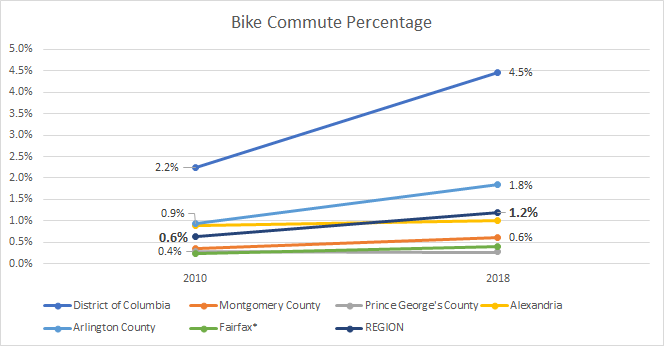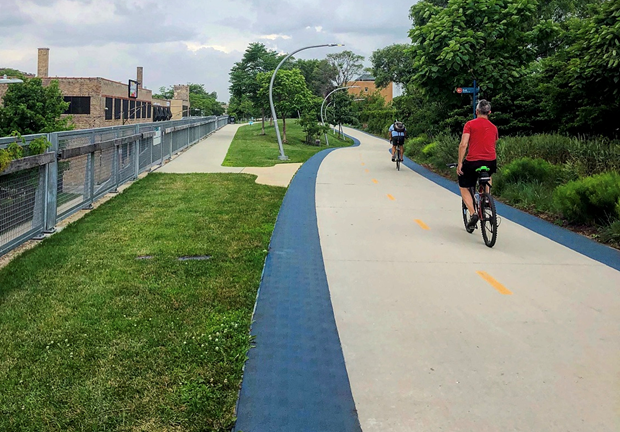How these six ‘spokes’ could make Washington a model biking region

DC Bike Party in Dupont Circle by Paul Lagoy used with permission.
This article was first published on Oct. 26, 2020. With Metro announcing reduced train service through the end of 2021, we thought this article was especially relevant.
As the Washington region recovers from the coronavirus pandemic and considers ways to build resilience, investing in biking could offer far-reaching benefits. A robust biking infrastructure can help improve health, and address climate change, systemic racism and economic hardship.
A summer-long project by Master’s students at Georgetown University’s Urban and Regional Planning program mapped out strategies to achieve an ambitious goal: to make the Washington region the best biking region in the country. Alongside five other students, we synthesized our findings and recommendations in an interactive web page that makes the case for why and how jurisdictions in the region can take action to reach this ambitious goal. The project was delivered to the Capital Trails Coalition, who served as the external community partner for the course.
As a region, there are a number of factors on our side: the existing trail network and commitment to its expansion; the success of Capital Bikeshare; progress on commute ridership; proliferation of the electric bike; and a new sense of urgency around climate, health and economic necessity to move away from car dominance.
From 2010 to 2018, the share of commuters traveling by bike in the region more than doubled. Data from American Community Survey 5-year estimates. *Fairfax includes Fairfax County, Fairfax City, and Falls Church. Image by the author.
Other cities around the world have made incredible strides in recent years — from Seville’s rapid bike lane build out earlier this decade, to more recent pandemic responses in places like Bogota, London and Milan. Amsterdam and Copenhagen were not always the cycling utopias they are today. They became that way because residents demanded it and local leaders prioritized it. The Washington region can do the same.
Our present car-based system has devastating effects on the environment and communities, particularly those of color. In addition to being the single largest contributing sector to US greenhouse gas emissions, our system has destroyed neighborhoods, limits mobility for many, saddles families with the economic burden of car ownership, and facilitates over-policing through traffic stops.
A typical DC bike lane scene on New York Avenue NW by the author.
An effective regional network of bike lanes and trails would expand mobility options, increasing access to employment, health services and other resources. This network would be especially meaningful for populations that are underserved by, yet depend on, public transit.
How to build a leading biking region:
We organized our recommendations into six “spokes,” which we view as the core components for making DC the best place for biking in the country. Our recommendations focus on increasing ridership, which will drive momentum to fund and build more bike infrastructure.
Throughout each of these steps, we must center equity and racial justice in the region’s bike planning practices. While new bike infrastructure can improve access to affordable and safe mobility options, new bicycle amenities sometimes bring fear of gentrification. Examples like the BeltLine in Atlanta or DC’s own Metropolitan Branch Trail show that improved public facilities can lead to harm if not accounted for with anti-displacement policies and programs. Knowing that improvements (of any kind) can promote gentrification and displacement, it is not acceptable to simply ignore the unintended consequences of an improved transportation system. It can be tempting to address equity concerns solely by talking more with potentially affected residents. While robust community engagement is vital for bicycle facilities, it is not a standalone solution to ensure an equitable outcome.
The six spokes are:
1. Build a connected and protected network of bike lanes. A robust and connected network of protected bike lanes is the first and most necessary step toward building a world class bike region. Bike lane construction has progressed with fits and starts, yet the region still lacks anything resembling a network of high quality, physically protected bike lanes — a major limitation on attracting new, less experienced riders. Those lanes that do exist are concentrated in wealthier, whiter areas like central DC and Arlington, with fewer in Prince George’s County and the eastern half of DC.
DC could fit a two-way protected bike lane on every road that is at least 40 feet wide. This map shows what such a network would look like. Image by the author.
2. Connect the region with a complete trail network. Nearly one in four residents in the immediate metropolitan area live within a half-mile of a Capital Trail Network trail, providing excellent recreation access for many. But our region’s trails are inequitably distributed and fail to meaningfully connect many communities, especially DC neighborhoods east of the Anacostia River and in Prince George’s County, to critical destinations. Completing the network, like the one envisioned by the Capital Trails Coalition and Transportation Planning Board, will put more than 1.5 million people and nearly a million jobs within walking distance of a high quality network trail.
Building the Capital Trails Coalition’s 40 priority trail projects could bring access to an additional 211,000 residents, 70% of whom are Black or Hispanic, primarily in northeast and southeast DC and Prince George’s County. Image by the author.
3. Design trails as destinations through placemaking and complementary infrastructure. Trails, like streets, are places in and of themselves, and should be treated as such. Investing in bike parking, way-finding, hydration stations, and public art can draw riders to well-maintained trails. A “showpiece” trail, like the Highline in New York City or the 606 in Chicago, has potential to draw publicity, catalyze ridership, increase political support, and ultimately, drive support for additional trail funding. The DC region has a number of potential showpiece trails that could serve this purpose.
The 606 in Chicago, an example of a “showpiece” trail. by Brandon Bratcher used with permission.
4. Aggressively advance trail-oriented development. Bike lanes and trails do not exist in a vacuum. They can only be as effective as the local land use context. Trail-adjacent land uses should deliberately seek to increase trail use, through trail-oriented zoning and design standards that maximize housing (especially for car-less households), jobs and trail-oriented activities near them.
5. Foster unique bike cultures. To become a premier biking region, we must foster inclusive, diverse and prominent bike cultures that welcome all potential riders. DC has a number of vibrant bike cultures and organizations, but we need more, and we need them to grow. Imagine a future in which our cultural devotion to private cars is replaced by a love of bicycles. A future in which people write songs, poems, and produce films romanticizing trails, rather than the open road. Or a future in which children can discover a sense of freedom and independence when they get their first bicycle, rather than pining for the day they get their driver’s license. Car culture did not develop organically — it was manufactured, marketed, and sold. Similarly, trails and bike culture can be cultivated, celebrated, and woven into our collective identity.
6. Enact policies that complement bike infrastructure. To get more people riding, biking must be made safer, cheaper, more convenient, and more comfortable than the alternatives. We need to rethink the way we incentivize and subsidize driving, from parking to fuel to insurance. We need safety policies such as banning right turns on red and legalizing the Idaho Stop. And, fundamentally, we need jurisdictions to be accountable for following through on infrastructure projects, as the recently passed Vision Zero Omnibus Act requires in DC.
